About Me [CV]

I am a Ph.D. student in the Department of Civil, Environmental, and Geo- Engineering at University of Minnesota, where I am co-advised by Professor Joseph Labuz and Professor Jia-Liang Le. My research focuses on understanding the mechanical behavior of quasi-brittle materials by numerical modeling and laboratory experiment. Besides, I am pursuing a master's degree in the Department of Computer Science and Engineering, where I explores different areas of interests: machine learning, computer graphics, parallel computing, etc. I enjoy integrating the knowledge from these two fields and doing interdisciplinary studies such as constructing machine learning framework to better identity damage mechanics in material with laboratory data.
- Email: huxxx853@umn.edu
- Address: 296 Civil Engineering Building
- Phone: 612-961-4380
Research Interest
- Experimental Rock Mechanics
- Acoustic Emission
- Digital Image Correlation
- Probabilistic Fracture Mechanics
- Data-driven Machine Learning
- Reliability Analysis
Education and Experience
Education
Ph.D. in Geo- Engineering
Sep 2019 - present
University of Minnesota-Twin Cities, MN
Advisor: Prof. Joseph Labuz and Prof. Jia-Liang Le
Specialization: experimental rock mechanics, probabilistic fracture mechanics and machine learning in mechanics
Master of Science in Computer Science
Sep 2021 - present
University of Minnesota-Twin Cities, MN
Emphasis: machine learning and computer graphics
Master of Science in Geo- Engineering
Sep 2017 - May 2019
University of Minnesota-Twin Cities, MN
Bachelor of Civil Engineering
Sep 2014 - May 2017
University of Minnesota-Twin Cities, MN
Emphasis: structural engineering
Professional Experience
Graduate Research Assistant
Sep 2017 - present
University of Minnesota-Twin Cities, MN
- Design and conduct experiments on quasi-brittle material including rock and SiC/SiC composites
- Perform numerical simulation and reliability analysis to extrapolate laboratory results to structural applications
- Construct machine learning framework to investigate damage mechanics with acoustic emission and digital image correlation data
Graduate Teaching Assistant
Sep 2017 - present
University of Minnesota-Twin Cities, MN
- Lecture Rock Mechanics and Civil Engineering Material laboratory session
Design Intern
Jun 2016 - Sep 2016
Minnesota Department of Transportation (MnDOT), Metro Design Office, MN
- Designed and drew construction plan for Minnesota highway with MicroStation
Undergraduate Research Assistant
Jan 2016 – May 2016
University of Minnesota-Twin Cities, MN
- Developed Finite Element code for Geo-Engineering slope stability problem
Research
Many modern engineering structures are composed of brittle heterogenous (a.k.a. quasi- brittle) materials, including concrete, composites, tough ceramics, rocks, etc. Both laboratory testing methods and analytical/numerical modeling are needed to investigate the damage and fracture behavior of quasi-brittle materials. My research goal is to bridge the gap between laboratory experiments and theoretical analysis of quasi-brittle material. Mechanical theories are used to guide the development of testing methods, and experimental results are used to reveal new findings with both traditional parametrical analysis and modern deep learning approaches. Probabilistic model is developed to extrapolate mechanical properties of lab-tested material to the design of actual structures, and reliability analysis is further evaluated.
Selected Research Projects
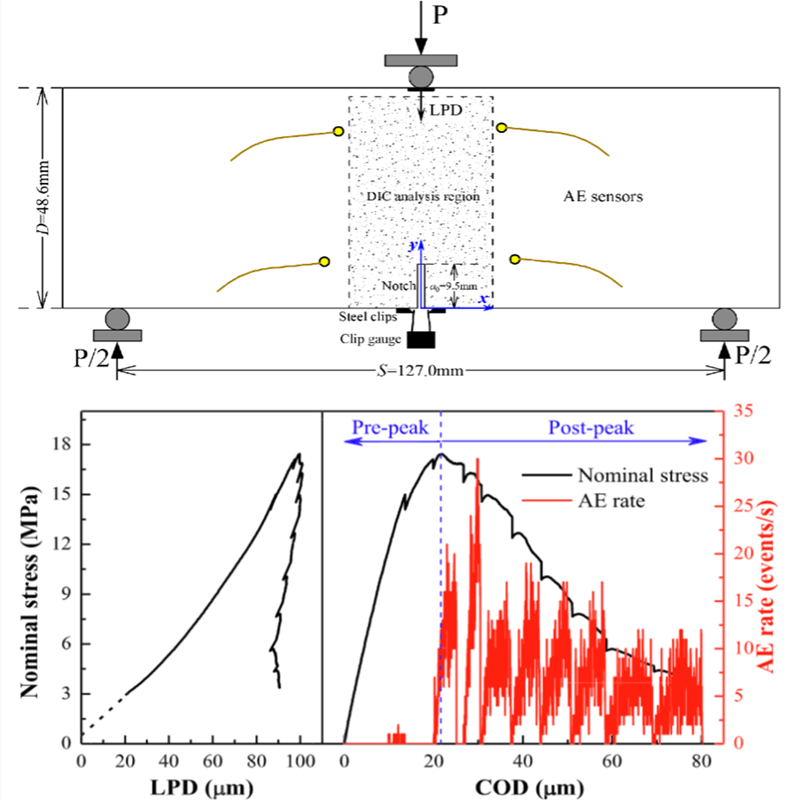
Experimental Investigation of Fracture in Rock
Acoustic emission (AE) and digital image correlation (DIC) are two common ways of monitoring fracture in quasi-brittle material. In this research, cracks in notched and smooth boundary rock specimens are introduced with three-point bending load configuration. The AE source location, together with the crack opening captured by DIC, is used to characterize the on-site damage and the formation and propagation of fracture process zone. Moment tensor analysis and size effect analysis are also produced to investigate the mechanical behavior of this rock.
The ultimate goal of this research is to experimental investigate the fracture process in quasi-brittle/brittle material, and relate that with the theory of fracture mechanics.
Related Publications:
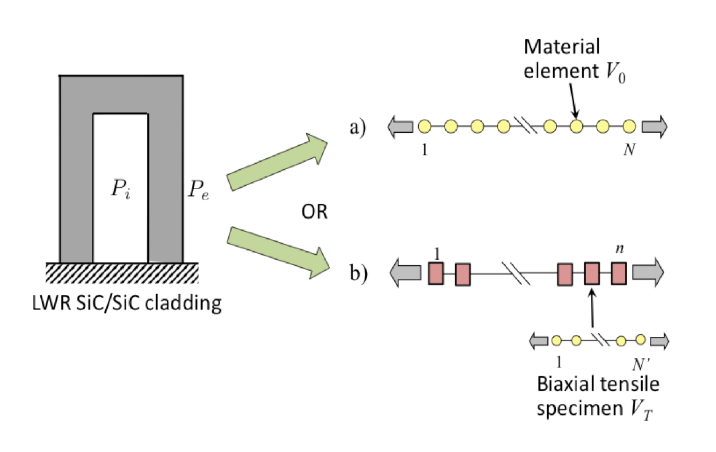
Probabilistic Time Dependent Model for SiC/SiC Composites
Material always incorporates randomness in strength, which is of paramount importance in the reliability-based design of engineering structures. In this study, we investigate the failure statistics of one type of quasi-brittle materials: SiC/SiC composites, in which a two-parameter Weibull distribution is used to describe the strength parameters. A finite weakest-link model is used to extrapolate material property of different sizes, which relates lab results to real applications.
The ultimate goal of this research is to develop a framework which integrates the probabilistic failure criterion into a reliability analysis of the structural integrity.
Ongoing Papers:
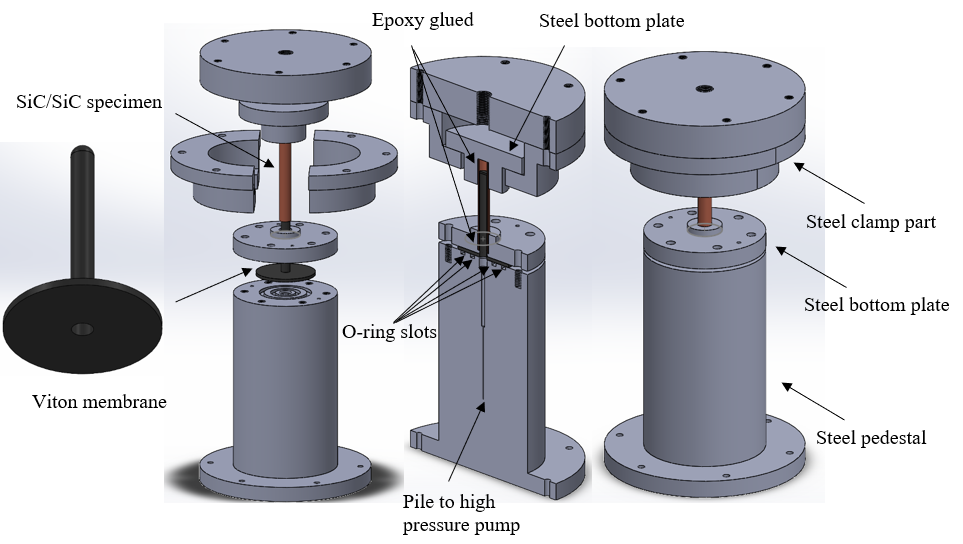
Multi-axial Testing System for Ceramics Tubular Specimen
Silicon carbide (SiC) fiber-reinforced SiC matrix (SiC/SiC) composites is a promising material used in high-temperature structural applications. However, ASTM only published standards for testing composites under uniaxial direction while no testing protocol has been formed for multi-axial testing. In this research, we designed a robust testing system which can successfully fracture the ceramics specimen to its ultimate limit with any load combination. A failure surface is formed with statistical data showed the material property under any stress conditions.
The major achievement of this research is a robust multi-axial testing system for tubular specimen of quasi-brittle material.
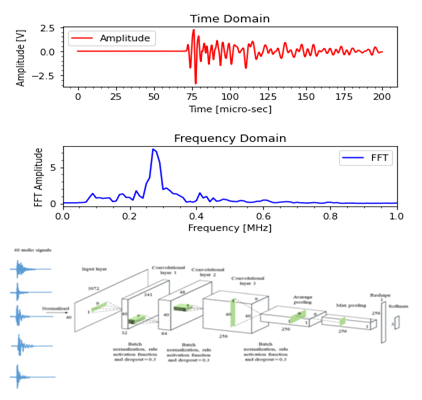
Characterization and Localization of Acoustic Emission Data with Deep Learning
Traditional parametrical analysis of acoustic emission data only uses limited information in wavelength due to the complex signal propagation. Deep Learning techniques which build highly nonlinear models have become an alternative way of characterizing and localizing AE data. In this research, both supervised and unsupervised learning methods are used to classify AE data. Moreover, the generalization of the model applied to different testing scenarios or actual applications is also under consideration.
The major emphasis of this research is to reveal the damage mechanics of material with the deep learning and acoustic emission data.
Ongoing Papers:
Projects
Reinforcement Learning
Reinforcement Learning for Game Super Crate Box
Reinforcement Learning is widely studied in game and robotics field. Inspired by OpenAI Gym, this project attempts to train a Deep Q Network (DQN) to create a player agent for the game Super Crate Box. Two refinements of the basic DQN algorithm: Double DQN and Dueling DQN are implemented and tested. Due to the lack of gym environment, generic cross-entropy (CE) method is also attempted, which creates an agent acting with a cowardly strategy. This half-successful agent avoids enemies for most of the time and can survive as long as possible. The project is implemented with Pytorch.
GitHub Repo:
Report:
Computer Graphics
Cloth Simulation
Physically based animation is a fun aspect of computer graphics, with both solid and fluid simulation. This project shows a 3D animation of cloth with user-controlled camera. The simulation treats cloth threads as a massive spring system and uses Hooke's law to calculate the displacement of each mesh joint. It uses Eulerian method with mid-point integration as well as considering spatial structure to minimize computation cost. The rendering is accomplished by Java with software Processing.
GitHub Repo:
Crowd Simulation and Motion Planning
Crowd simulation shows how pedestrians find routes from origins to destinations. In this project, the social force model by Dr. Helbing is used as local interaction technique, while the global navigation is attempted by both probabilistic roadmap (PRM) and A* algorithm.
The simulation shows a success scenario where several pedestrians pass through local minima - a hallway between two rooms and a failure scenario where two sets of pedestrians walk across each other. Besides, a maze testing scenario is also created where agents try to find shortest path from start to end position. The Dijkstra's algorithm is implemented here as the search tree.
GitHub Repo:

Ray Tracing and Real-time Game Engine Pipeline
Ray tracing and real-time rendering pipeline play as the core component of modern game engine. In this project, offline ray tracing is first attempted with reflection and refraction to some depths. A real-time rendering pipeline or game engine is then adapted, with frustum culling and level of detail (LOD) techniques implemented. Two games are created based on the adapted game engine: a first-person shooter (FPS) game and a 2.5D platform game. A collision detection system is also implemented and embedded into the game engine. The project is accomplished by OpenGL and animated characters is created with software Blender.
GitHub Repo:
Recommender System
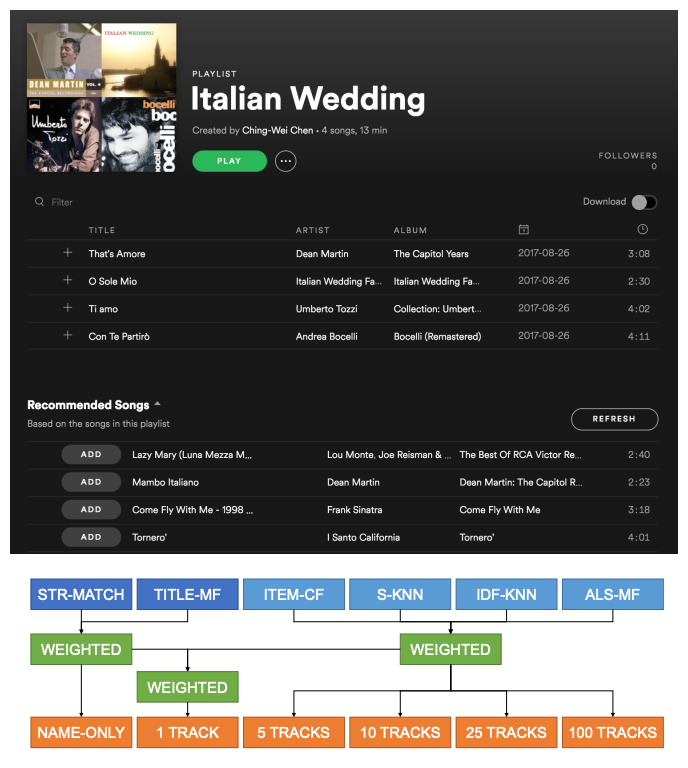
Spotify Million Playlist Dataset Challenge -- Automatic Playlist Continuation
Automatic playlist continuation is a common task of music recommender systems, which automatically discovers tracks that fit into a given playlist. In this project, we replicate and extend a paper named Effective Nearest-Neighbor for Music Recommendations. Four different aspects are extended from original system: (1) different size of datasets (2) a new SVD-based approach added to original hybrid recommender (3) Pearson similarity as parameter tuning (4) new evaluation matrix such as recall, F1 and RMSE. We want to further investigate this problem with modern reinforcement learning in the near future. The project is accomplished by Python with Pandas Library.
GitHub Repo:
Report:
Computer Vision
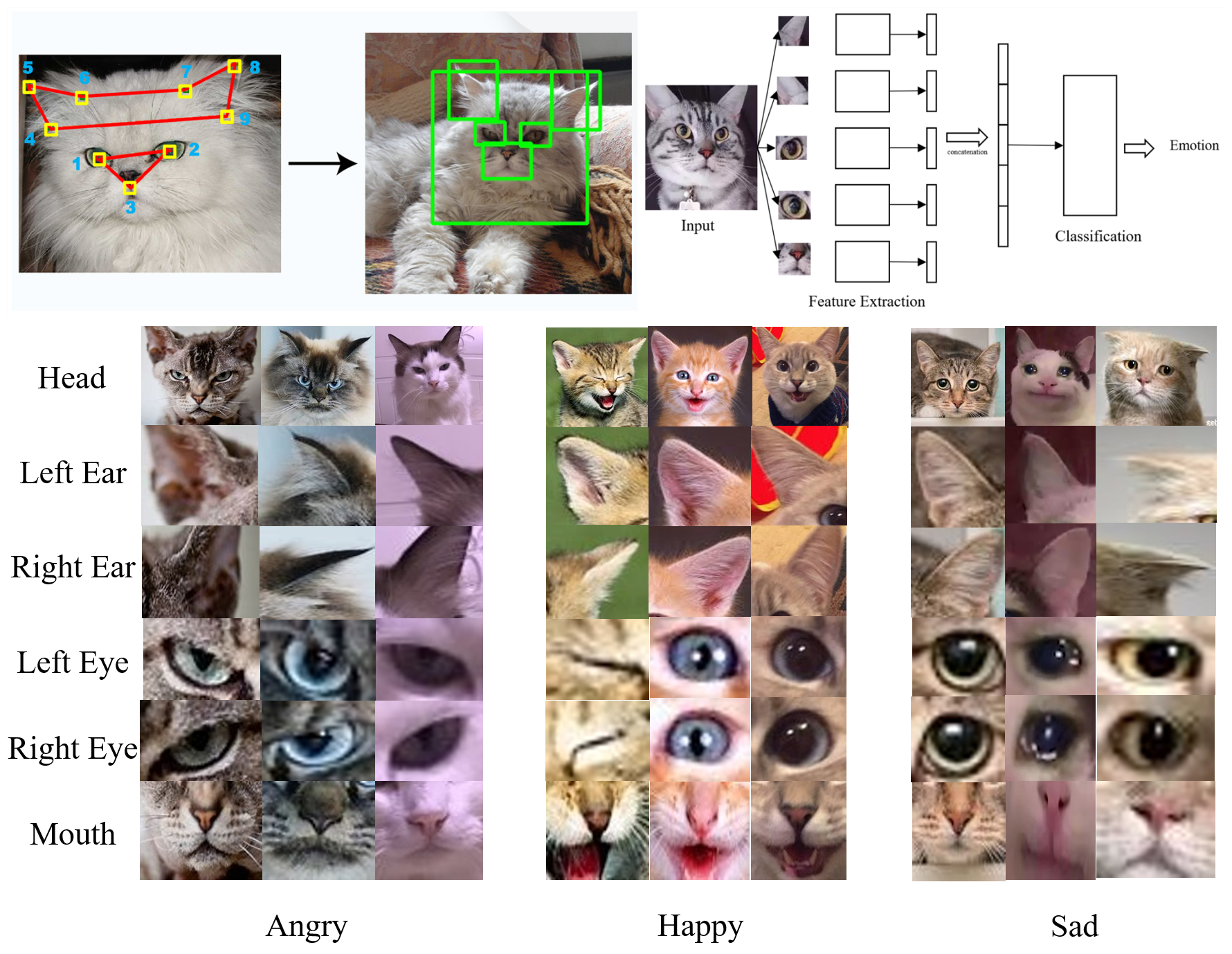
Emotion Recognition Based Dubbing for Soundless Cat Video
Emotion recognition has been well studied for human, but not for animals. In this project, a study on emotion recognition is presented for cats. Facial expression, which is the most crucial part of detecting cat emotion, is classified with a pipeline where cat face detection, facial feature extraction, mouth open/close detection is included. Also, an AI dubbing for soundless videos of cats is created in which we can tell when cats would miaow from their mouth movement. In advance, we can tell what type of sounds those cats would generate by recognizing cats’ facial expression and relating those to cats’ emotions. The project is implemented with TensorFlow.
GitHub Repo:
Report:
Interactive Website
"Hunting Food You Like" Website
In this project, an interactive website/app is created to find good restaurant nearby with Yelp API. Users can save restaurants to the wish list for upcoming visit. They can also write comments and take photos to share their experience. The website also integrates a google map which shows route from current location to the desire restaurant. Users can also add this responsive website to their phone home screen for future access. This website is made with Vue and hosted on Firebase Hosting. It uses Google Cloud Firestore for data storage and Firebase Authentication tool.